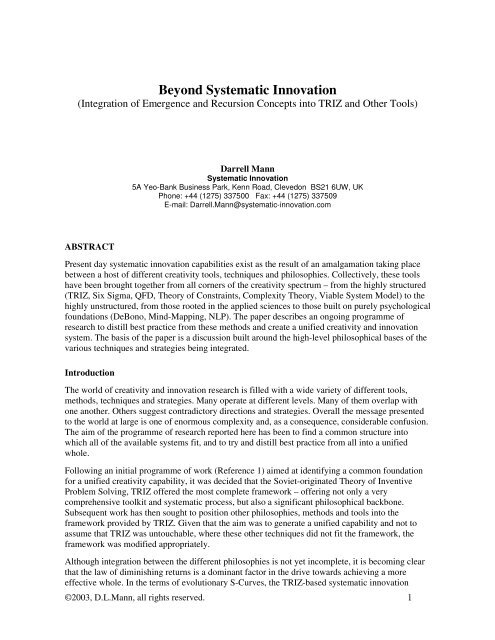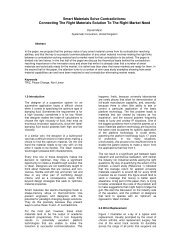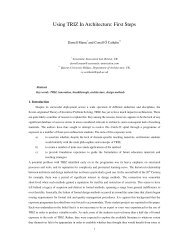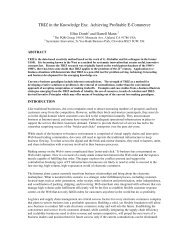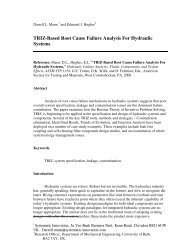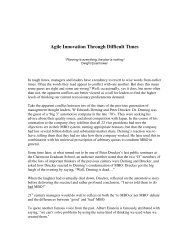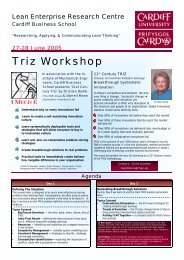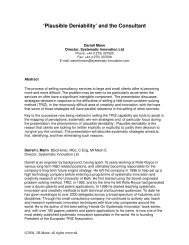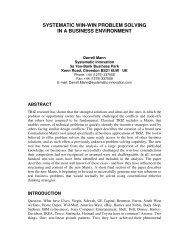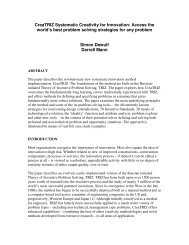Beyond Systematic Innovation
Beyond Systematic Innovation
Beyond Systematic Innovation
Create successful ePaper yourself
Turn your PDF publications into a flip-book with our unique Google optimized e-Paper software.
<strong>Beyond</strong> <strong>Systematic</strong> <strong>Innovation</strong><br />
(Integration of Emergence and Recursion Concepts into TRIZ and Other Tools)<br />
Darrell Mann<br />
<strong>Systematic</strong> <strong>Innovation</strong><br />
5A Yeo-Bank Business Park, Kenn Road, Clevedon BS21 6UW, UK<br />
Phone: +44 (1275) 337500 Fax: +44 (1275) 337509<br />
E-mail: Darrell.Mann@systematic-innovation.com<br />
ABSTRACT<br />
Present day systematic innovation capabilities exist as the result of an amalgamation taking place<br />
between a host of different creativity tools, techniques and philosophies. Collectively, these tools<br />
have been brought together from all corners of the creativity spectrum – from the highly structured<br />
(TRIZ, Six Sigma, QFD, Theory of Constraints, Complexity Theory, Viable System Model) to the<br />
highly unstructured, from those rooted in the applied sciences to those built on purely psychological<br />
foundations (DeBono, Mind-Mapping, NLP). The paper describes an ongoing programme of<br />
research to distill best practice from these methods and create a unified creativity and innovation<br />
system. The basis of the paper is a discussion built around the high-level philosophical bases of the<br />
various techniques and strategies being integrated.<br />
Introduction<br />
The world of creativity and innovation research is filled with a wide variety of different tools,<br />
methods, techniques and strategies. Many operate at different levels. Many of them overlap with<br />
one another. Others suggest contradictory directions and strategies. Overall the message presented<br />
to the world at large is one of enormous complexity and, as a consequence, considerable confusion.<br />
The aim of the programme of research reported here has been to find a common structure into<br />
which all of the available systems fit, and to try and distill best practice from all into a unified<br />
whole.<br />
Following an initial programme of work (Reference 1) aimed at identifying a common foundation<br />
for a unified creativity capability, it was decided that the Soviet-originated Theory of Inventive<br />
Problem Solving, TRIZ offered the most complete framework – offering not only a very<br />
comprehensive toolkit and systematic process, but also a significant philosophical backbone.<br />
Subsequent work has then sought to position other philosophies, methods and tools into the<br />
framework provided by TRIZ. Given that the aim was to generate a unified capability and not to<br />
assume that TRIZ was untouchable, where these other techniques did not fit the framework, the<br />
framework was modified appropriately.<br />
Although integration between the different philosophies is not yet incomplete, it is becoming clear<br />
that the law of diminishing returns is a dominant factor in the drive towards achieving a more<br />
effective whole. In the terms of evolutionary S-Curves, the TRIZ-based systematic innovation<br />
©2003, D.L.Mann, all rights reserved. 1
method is approaching some form of fundamental limit – Figure 1. To go beyond these limits – in<br />
other words, to find a new paradigm, higher level of creativity capability – requires an expansion of<br />
TRIZ in fundamental ways. Thus, while some integration activities look set to enable small-scale<br />
optimisation benefits to be accrued, more substantial shifts in capability seem likely only through<br />
more profound shifts in the underpinning philosophy.<br />
Ideality/<br />
Capability<br />
current<br />
position<br />
composite<br />
‘new generation’<br />
s-curve<br />
Composite<br />
‘systematic innovation’<br />
s-curve<br />
Time<br />
Figure 1: Evolution of <strong>Systematic</strong> <strong>Innovation</strong> Capabilities in S-Curve Terms<br />
Two emerging sciences and one industry-based system – Six Sigma – appear to be offering the<br />
potential to deliver such philosophy shifts. The shifts they suggest are complexity emerging from<br />
bottom-up principles, recursion and customer focus respectively. The paper discusses all three<br />
concepts in the context of their impending impact on the world of systematic creativity and<br />
innovation, and in particular their potential to deliver completely new thinking paradigms.<br />
Existing <strong>Systematic</strong> <strong>Innovation</strong> Capability<br />
In order to begin the discussion, it is first necessary to discuss the framework provided by an<br />
evolved version of the TRIZ method. Figure 2 – taken from Reference 2 – aims to present the<br />
totality of TRIZ-based systematic innovation in terms of its philosophical roots, the overall<br />
methodology processes, and the individual tools that make up that overall process.<br />
Excellence<br />
Ideality<br />
Resource<br />
Functionality<br />
Contradiction<br />
Space/Time/Interface<br />
Philosophy<br />
ARIZ<br />
<strong>Systematic</strong> <strong>Innovation</strong><br />
Method (SIM)<br />
Define-Select-Generate-Evaluate<br />
Method<br />
Inventive Principles IFR<br />
Contradiction Matrix<br />
Trends<br />
S-Fields<br />
Function Knowledge/<br />
Subversion<br />
Analysis Effects<br />
Analysis<br />
PI Tools<br />
Tool<br />
Trimming<br />
Resources<br />
Separation Principles<br />
Figure 2: Current TRIZ-Based <strong>Systematic</strong> <strong>Innovation</strong> Operating Hierarchy<br />
At the very highest level of the TRIZ philosophy is the concept of distillation of excellence from all<br />
sources of knowledge. This is the root enabling TRIZ to be receptive to other techniques. One of<br />
the commonly used TRIZ expressions is ‘someone, somewhere has already solved your problem’.<br />
©2003, D.L.Mann, all rights reserved. 2
In order then to allow users to readily find those solutions, it has been necessary to cast the widest<br />
possible net.<br />
Slightly below this level, the five main philosophical pillars of TRIZ are:-<br />
IDEALITY: all successful innovations evolve in a direction of increasing ideality – more benefits;<br />
less cost, less harm. Evolution towards an ideal final result occurs through a series of patterns that<br />
are repeated across different industries.<br />
CONTRADICTION: systems evolve in the direction of increasing ideality through the successive<br />
emergence and resolution of conflicts and contradictions. Evolution is therefore fundamentally<br />
discontinuous in nature. The contradiction-eliminating strategies of others have been mapped and<br />
can be used to accelerate the evolution of any system.<br />
FUNCTION: customers primarily buy functions (benefits), therefore producers should focus on the<br />
function delivered by the products and services they deliver and not just the product itself. If<br />
customers find a better way of achieving a function, they will stop buying your product or service.<br />
RESOURCES: anything in or around a system that is not being used to its maximum potential is a<br />
resource. Even the things we might think of as ‘bad’ or harmful in a system can become useful<br />
resources if we are able to change our perspective of them.<br />
SPACE/TIME/INTERFACE: the human brain is subject to an effect known as psychological<br />
inertia; it fools itself into looking at situations from one specific angle. When we are looking to<br />
improve a system, we need to be able to change our perspective of it. Perspective shifts can involve<br />
physical (or virtual) space, temporal issues, or the way in which different elements of a system<br />
interface and relate to one another.<br />
Taken together, these pillars offer users the capability to direct their creative efforts in directions<br />
that are known to deliver success. There are, of course, other ways to think about the creative<br />
process – very often in fact it is very desirable to employ deliberately unstructured approaches that<br />
permit drift in quite random directions. One of the big underlying concepts of TRIZ – primarily<br />
coming from the Ideality and Functionality pillars – is that when we wish it, there is a system that<br />
will systematically focus us in directions that are purely success-oriented.<br />
In order to examine how other systems might compare and integrate with the systematic innovation<br />
structure, we may see that many operate at purely the methodological or tool level. We will<br />
individually examine the three that appear to offer most at the highest philosophical level. That<br />
process begins with Six Sigma:<br />
Six Sigma<br />
The Six Sigma methodology is primarily an industry created and industry deployed collection of<br />
best practices developed over the history of manufacture and service industries. In large part it is an<br />
assembly of tools, methods and philosophies from Statistical Process Control and Total Quality<br />
Management. Thanks to some significant bottom-line business benefits reported by lead users, Six<br />
Sigma currently carries a very high profile and is the subject of a variety of management texts (see<br />
for example References 3, 4). None of these texts has particularly sought to divide the whole into<br />
different hierarchical levels, but by extracting the appropriate knowledge from the best of the texts,<br />
we will arrive at an equivalent of the <strong>Systematic</strong> <strong>Innovation</strong> hierarchy map as shown in Figure 3.<br />
By again focusing only on the high level philosophical tenets, we can observe the following as the<br />
main over-riding elements of Six Sigma:<br />
©2003, D.L.Mann, all rights reserved. 3
VALUE<br />
CUSTOMER<br />
CONTINUITY<br />
UNITY<br />
Several versions of<br />
Plan-Do-Study-Act<br />
(PDSA)<br />
or<br />
Define-Measure-Analyse-Improve-Control<br />
(DMAIC)<br />
Philosophy<br />
Method<br />
Pareto Analysis<br />
(Taguchi)<br />
(Root Cause Analysis)<br />
(TRIZ)<br />
Fishbone Diagrams SPC<br />
(QFD)<br />
(FMEA)<br />
MGP (Kano analysis)<br />
(assorted statistical analysis tools) Process Mapping<br />
Tool<br />
Figure 3: Philosophy-Method-Tool Hierarchical Perspective of Six Sigma<br />
CUSTOMER: the main underlying philosophy of Six Sigma is the focus on customers and the<br />
satisfaction of the needs and desires of those customers, whether they be internal or external to an<br />
organisation.<br />
VALUE: Added value is what makes a customer select one product or service over another one. Six<br />
Sigma thus places considerable importance on the addition of value, and more specifically, the<br />
reduction and elimination ‘non-value added’ activities of which variation is seen as a key element.<br />
CONTINUITY: improvement of systems and processes must be a continuous activity; there is no<br />
justification for relaxation of efforts to eliminate variation and waste.<br />
UNITY: a successful Six Sigma initiative needs to involve everyone working within the system.<br />
There can be no exceptions to this rule; buy-in is essential.<br />
The Six Sigma philosophy can then be seen to have the following three impacts on the initial<br />
systematic innovation framework:<br />
1) Successful innovation gives customers more ideality; all of the functions (benefits) they want at<br />
ever lower cost and harm. Every customer is different from every other customer and in the ideal<br />
world, every individual customer gets exactly what they want.<br />
2) TRIZ has traditionally described evolution happening in discontinuous bursts and suggests that<br />
in large part these bursts are driven by market demands. Thus, there are times when an introduced<br />
innovation will succeed and other times when it will not. Whether there is an apparent ‘market<br />
need’ or not, the CONTINUITY pillar of Six Sigma suggests that the innovation process should be<br />
continuous. The idea of generating an innovation that does not have a market demand appears to<br />
make little sense. The parallel phenomena of increasingly rapid global change and the increasing<br />
importance of intellectual property (at least at the present time), however, do appear to suggest the<br />
validity of a continuous innovation philosophy; even if the market is not ready for an innovation,<br />
doesn’t mean that a company shouldn’t own the rights to it.<br />
3) If you don’t get ‘buy-in’ from EVERYONE, an innovation will fail. Traditional TRIZ thinking<br />
pays no attention to buy-in. Lack of buy-in is probably the biggest single killer of TRIZ – or indeed<br />
©2003, D.L.Mann, all rights reserved. 4
any – generated innovations – see for example our previous article on ‘if TRIZ is so good, why<br />
isn’t everyone using it (Reference 5).<br />
Recursion<br />
Stafford Beer’s Viable System Model emerged from the study of organisation structures and<br />
resulted in two very important conceptual findings. The first involved the identification of five<br />
essential elements that a system had to contain if it were to be ‘viable’. The second involved the<br />
idea of recursiveness – and the discovery that the five element viability test still applied at different<br />
hierarchical levels of consideration of a system organisation structure. Reference 6 describes how<br />
this first finding contradicts the TRIZ definition of ‘system completeness’ and how it ultimately<br />
therefore provides a stronger definition of completeness than TRIZ. The second concept of<br />
recursion is still only just being introduced into the systematic innovation framework.<br />
The simple philosophical finding of Beer and others (see for example work on Spiral Dynamics –<br />
Reference 7) is that there are strong elements of self-similarity between systems as we switch our<br />
focus from the macro scale to the micro-scale and vice versa. As far as Beer was concerned, the key<br />
self-similarity feature in organisations was that ‘viability’ demanded certain elements to be present<br />
at each hierarchical level. From a technical perspective, to take the specific example of helical flow,<br />
what the recursion idea allows us to do is apply solutions from one scale to another. Several natural<br />
systems operating at the micro-scale often evolve complex helical geometry forms that maximise<br />
flow efficiency. Likewise, macro-scale study of interplanetary motion have highlighted the<br />
presence of similar helical effects. Designers of novel heat exchangers – i.e. operating at a scale<br />
between these two extremes – were able to hypothesise that the same effect may be able to be used<br />
in the design of highly efficient configurations, and in fact were able to create a paradigm-changing<br />
improvement in performance as a result. The helical flow effect is thus seen to be recurrent at<br />
different size scales.<br />
Closer to the systematic innovation arena is another recursion idea, this time the recognition that as<br />
systems evolve through successive disruptive shifts from one system (s-curve) to another, the<br />
complexity of the respective systems passes through a characteristic increasing-decreasing profile –<br />
Figure 4. According to preliminary work (Reference 8), this recursive effect allows us to utilise the<br />
parts of the systematic innovation toolkit most relevant to a given phase in the complexity cycle.<br />
Increases<br />
Complexity<br />
Decreases<br />
Figure 4: Recursion In System Complexity Evolution<br />
Complexity Theory<br />
To reduce the entire scientific and mathematical base of complexity theory to a single philosophical<br />
foundation is probably a little unfair given the breadth and depth of work being devoted to the<br />
subject. Nevertheless, there is at least some justification for suggesting that the whole field emerged<br />
as a result of a very simple idea; that enormously complex systems emerge from what my be<br />
extremely simple base rules and principles. The interaction of individually simple elements, in<br />
other words, can produce some highly unexpected outcomes.<br />
©2003, D.L.Mann, all rights reserved. 5
One of the main applications of systematic innovation involves the use of uncovered trends of<br />
evolution to predict what future generations of designs and systems will look like. In order to<br />
illustrate the likely impact of the ‘emergent complexity’ philosophy on systematic innovation, in<br />
this section we examine the process of system evolution through the lens of emergent market<br />
complexity.<br />
Many researchers have spent considerable amounts of time and energy failing to translate well<br />
known and well established trend directions – for example the list illustrated in Figure 5 – into<br />
useful predictions of how a market will evolve. In essence, they form the simple base rules upon the<br />
complex world we live in has emerged. We examine why predictions using these trends tend to be<br />
wrong and highlight a simple strategy for improving our chances of getting the predictions right in<br />
the future.<br />
* Increasing ELECTRONIC COMMUNICATION in private life<br />
* Increasing GAP between have’s and have-not’s<br />
* Increasing NEED FOR DIFFERENTIATION between business customers<br />
* Increasing INFORMATION VOLUME<br />
* Need for SIMPLICITY<br />
* Global AVAILABILITY OF SERVICES<br />
* Wish for INDIVIDUAL SOLUTIONS (private customers)<br />
* DEMOGRAPHIC TRENDS (aging population, DINKs)<br />
* Wish for SELBSTVERWIRKLICHUNG (‘making the most of one’s life’)<br />
* TIME as a valuable resource<br />
Figure 5: Well Known Customer Trend Directions<br />
The only sure-fire result of a ‘simple’ market evolution prediction method is that it will be wrong.<br />
The method being proposed here – if we use it correctly – is certainly not simple, but it does use the<br />
idea of constructing complexity from simple building blocks. The principles through which the<br />
method operates are simple enough to be described relatively quickly. In-line with complexity<br />
theory, what we are looking at here is a means of assembling highly complex models from some<br />
very simple ‘first principles’ building blocks. Our purpose here is to merely to describe some of<br />
those building blocks and the operating principles through which we can assemble them together to<br />
form a robust and reliable model of market evolution dynamics.<br />
All of the trend directions suggested in Figure 5, or that we might find in the continuous stream of<br />
MegaTrends books (Reference 9 for example), or the output of Faith Popcorn (Reference 10),<br />
‘work’ so long as the linear assumptions they make remain valid. Anyone living in the real world,<br />
of course, knows that any linear assumption is bound to go wrong sooner or later because the world<br />
is not a linear place. The predictions made from a single trend go wrong because something comes<br />
along and says ‘hey, you can’t keep going down that road anymore’. Something, in other words,<br />
comes along and stops the trend from working beyond a certain point.<br />
We can very simply see what it is that comes along and stops a trend from working when we begin<br />
to consider multiple trends. For the sake of simplicity, we will examine just two. Figure 6 illustrates<br />
two of the market trend directions picked at random from the Figure 5 list. We could actually have<br />
picked literally any pair in order to demonstrate the point. In the figure, then, the two trends are<br />
progressing as a function of time as per prediction. As shown in the figure, their trajectories are<br />
slightly different.<br />
©2003, D.L.Mann, all rights reserved. 6
Linear Trend 1<br />
TIME<br />
Linear Trend 2<br />
Figure 6: Two Linear Trends In Action<br />
The progression along these two trend paths will continue as per prediction until such times as the<br />
differences between them result in some kind of mis-match – further advance along one trend<br />
becomes inconsistent with progress along the other. When this happens, there is a conflict. When a<br />
conflict occurs, one or both of the trends can no longer progress according to the predictions.<br />
Further progress, in fact, can only occur when the conflict has somehow been resolved – Figure 7.<br />
Linear Trend 1<br />
CONFLICT<br />
EMERGES<br />
CONFLICT<br />
RESOLVED<br />
Linear Trend 2<br />
Figure 7: Two Linear Trends In Conflict With One Another<br />
Despite the fact that this model is both generic and simplistic (it fails to recognize, for example, that<br />
every individual customer is different and has a different affinity to any given trend pattern), it<br />
forms a very solid foundation upon which really effective market evolution models can be<br />
constructed. The immediate link with the contradiction elimination philosophy of TRIZ is that we<br />
can systematically work to eliminate the identified contradictions using the successful strategies of<br />
others (Reference 2).<br />
To again stick with just two trends, we can begin to see how this might be so by examining a<br />
modified version of the process described in Reference 11:<br />
1) pick two trends<br />
2) define an ideal final result (IFR) end point to each of the trends<br />
3) extrapolate along both trends in the direction of the two ideal final results and reveal the<br />
contradiction that emerges<br />
4) use the Inventive Principles of TRIZ to explore means by which the contradiction can be<br />
eliminated.<br />
Let’s take an example using a pair of trends from Figure 5. Firstly the trend towards a desire for<br />
simple solutions, and secondly the trend towards individualized solutions. Extrapolating to the IFR<br />
in the first case might give us something like ‘every system does exactly what the user wants<br />
without the user ever having to learn any set of instructions’. Extrapolating to the IFR in the second<br />
©2003, D.L.Mann, all rights reserved. 7
case might in turn give us something like ‘every individual customer gets exactly the product or<br />
service they want’.<br />
Hopefully the contradiction between the two evolution directions suggested by these end points<br />
becomes clear very quickly; systems must be simple for any individual user, but must also be<br />
different to take account of the fact that every customer is different. Until this simple versus<br />
adaptive contradiction is resolved, one or both of the ‘increasing simplicity’ or ‘individual<br />
solutions’ trends can no longer continue to apply.<br />
The smart forecaster will use this information to start identifying solutions to the conflict before<br />
they actually happen. For example, the increasing emergence of self-learning/adaptive computer<br />
systems is an increasingly used technology that admirably helps to solve the conflict. Combine this<br />
idea with organizations like Amazon that acquire more and more data about their customers the<br />
more they buy and we’re well on the way to learning systems that know what an individual<br />
customer is like before the product arrives on the doorstep.<br />
In many senses, what we have just done here is similar to what we would have done in a traditional<br />
scenario planning exercise. There we would have taken two trends, extrapolated along them to<br />
some point in the future and used the resulting market situation as the environment in which our<br />
product or service should be designed to fit. The big difference here of course is that in the new<br />
method we are extrapolating two simple bottom-up trend directions to stably positioned end points<br />
(the two IFRs) and are actively looking to resolve the contradiction that emerges rather than trying<br />
to accommodate and trade-off.<br />
Scenario planning sessions rarely extend to looking at more than two or three trends at a time due<br />
to the complexity involved. The net result of this is that scenario planning exercise deliver reliable<br />
outputs. The implication from the findings of TRIZ on the other hand – that the evolution process<br />
acts as the successive emergence and resolution of conflicts and contradiction – provides us with a<br />
number of clues that will help us to manage this complexity issue.<br />
For this paper we will simply leave readers with the concept of identifying the two most dominant<br />
trends in a particular situation and using the conflict emergence and resolution strategy as a means<br />
of identifying and eliminating the conflicts before they occur in reality. We suggest this because<br />
early identification of emerging conflicts may well be enough to give us an edge in the competitive<br />
world we live in. If you think about it, ‘competitive edge’ is essentially the function and raison<br />
d’etre of the forecasting process anyway.<br />
Thinking ahead a little bit, what the market trend conflict concept allows us to do when we start<br />
looking at the whole thing rather than just one or two select bits is to manage the complex future<br />
picture in rather more sophisticated ways. Here’s a final thought that you might like to consider<br />
before we return to it in a future paper (Reference 12): If we take all of the known market evolution<br />
trends and arrange them in a Matrix we can look at every pair in turn in order to see whether there<br />
might be any recurring patterns of conflict emergence. If there are such emergent patterns – certain<br />
contradictions that come up again and again for different pairs of trend directions – then we can<br />
probably begin to imagine that the process of designing the future will change considerably.<br />
Final Thoughts and Future Work<br />
The work reported here is still at a relatively early stage. It is believed that at the philosophical<br />
level, a solid foundation upon which a new generation of systematic innovation capability can be<br />
built has been created. The main tenets of that combined philosophy are illustrated in Figure 8.<br />
Taken together, the philosophical elements of TRIZ-based systematic innovation, Six Sigma,<br />
Recursion and Complexity Theory create seven main ideas that when used collectively will provide<br />
©2003, D.L.Mann, all rights reserved. 8
a highly effective focused creativity capability. The next parts of the research will involve<br />
appropriate integration of the different systems at the methodological level. This work is currently<br />
underway in the form of the CREAX <strong>Innovation</strong> Suite software system. The main design principle<br />
of the system – which operates irrespective of whether it is deployed in software or other forms – is<br />
again the concept that someone, somewhere has already solved the problem. Or at least elements of<br />
the problem. What the <strong>Innovation</strong> Suite aims to do is integrate all of those individual elements into<br />
a coherent, easy-to-use whole.<br />
UNITY<br />
RECURSION<br />
RESOURCES<br />
EMERGENCE<br />
CONTRADICTION<br />
FUNCTION/VALUE<br />
CUSTOMER IDEALITY<br />
Figure 8: Collected Philosophical Concepts of New Generation <strong>Systematic</strong> <strong>Innovation</strong><br />
References<br />
1) Mann, D.L., ‘Evolving The World’s Best Creativity Methods’, TRIZ Journal, www.trizjournal.com,<br />
April 2002.<br />
2) Mann, D.L., ‘Hands-On <strong>Systematic</strong> <strong>Innovation</strong>’, CREAX Press, April 2002.<br />
3) Tennant, G., ‘Six Sigma – SPC and TQM in Manufacturing and Services’, Gower, 2001.<br />
4) Tennant, G., ‘Design For Six Sigma’, Gower, 2002.<br />
5) CREAX Newsletter, ‘If TRIZ Is So Good, Why Isn’t Everyone Using It, Part 37’,<br />
www.creax.com, Archives, May 2003.<br />
6) Mann, D.L., ‘Laws of System Completeness’, TRIZ Journal, May 2001.<br />
7) Lessem, R., Beck, D., Cowan, C., ‘Spiral Dynamics: Mastering Values, Leadership, and<br />
Change’, Blackwell Publishers, 1996.<br />
8) Mann, D.L., ‘Complexity Increases And Then…’, TRIZ Journal, January 2003.<br />
9) Naisbitt, J., Aburdene, P., ‘MegaTrends 2000’, Sidgwick & Jackson, 1990.<br />
10) Popcorn, F., ‘Clicking’, HarperCollins, 1996.<br />
11) Salamatov, Y., ‘TRIZ: The Right Solution At The Right Time’, Insytec, The Netherlands,<br />
1999 (page 161).<br />
12) Mann, D.L., Dewulf, S., ‘Emergent Complexity From Linear Trends And How To Manage<br />
It’, paper to be published in TRIZ Journal, November 2003.<br />
©2003, D.L.Mann, all rights reserved. 9


